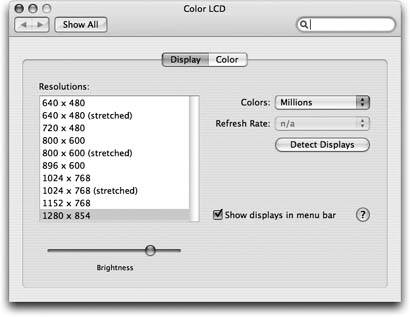Section 13.11. Displays
Displays is the center of operations for all your monitor settings. Here, you set your monitor's resolution , determine how many colors are displayed onscreen, and calibrate color balance and brightness.
Tip: On a laptop, you can open up this panel with a quick keystroke from anywhere on the Mac. Just press Option as you tap one of the screen-brightness keys (F1 or F2) on the top row of your keyboard.
The specific controls you'll see here depend on the kind of monitor you're using, but here are the ones you'll most likely see.
13.11.1. Display Tab
This tab is the main headquarters for your screen controls. It governs these settings:
-
Resolutions . All Mac screens can make the screen picture larger or smaller, thus accommodating different kinds of work. You perform this magnification or reduction by switching among different resolutions (measurements of the number of dots that compose the screen). The Resolutions list displays the various resolution settings your monitor can accommodate: 800 x 600, 1024 x 768, and so on (Figure 13-9).

Figure 13-9. In the early days of computing, higher color settings entailed a speed hit, since it took time to compute the color for thousands of individual pixels. Today, there's little downside to leaving your screen at its maximum depth setting ("Millions" of colors). Photos, especially , look best at higher depth settings. (The Detect Displays button appears primarily on laptops; it means, "Check to see if I've attached an external monitor or projector.")
When you use a low-resolution setting, such as 800 x 600, the dots of your screen image get larger, thus enlarging (zooming in on) the picturebut showing a smaller slice of the page.
-
Colors . Today's Mac monitors offer different color depth settings, each of which permits the screen to display a different number of colors simultaneously . The Colors pop-up menu generally offers three choices: 256 Colors, Thousands, and Millions.
-
Refresh Rate . This pop-up menu (available for CRT screens onlythat is, not flat panels) lets you adjust how many times per second your screen image is repainted by your monitor's electron gun. Choose a setting that minimizes flicker.
-
Brightness, Contrast . Use these sliders to make the screen look good in the prevailing lighting conditions. The Contrast control appears only on CRT monitors, and you'll usually want it all the way up. The Brightness slider is usually best near the middle.
Of course, most Apple keyboards have brightness-adjustment keys , so these software controls are included just for the sake of completeness.
Tip: You can adjust the color depth and resolution of your monitor without having to open System Preferences. Just turn on "Show displays in menu bar," which adds a Monitors pop-up menu (a menulet [Section 1.6]) to the right end of your menu bar for quick adjustments.
-
Automatically adjust brightness as ambient light changes . This option appears only if you have a PowerBook with a light-up keyboard. In that case, your laptop's light sensor also dims the screen automatically in dark rooms if this checkbox is turned on.
13.11.2. Geometry Tab
This pane appears only on Macs with built-in, non-flat screensfor the most part, that means eMacs and the older, fruit-colored iMacs. It lets you adjust the position, size , and angle of the screen image on the glass itselfcontrols that can be useful in counteracting distortion in aging monitors.
13.11.3. Arrange Tab (Multiple Monitors)
From the dawn of the color-monitor era, Macs have had a terrific feature: the ability to exploit multiple monitors all plugged into the computer at the same time. All Macs can project the same thing on both screens ( mirror mode ), which is useful in presentations when the "external monitor" is a projector. A few lucky models permit one monitor to act as an extension of the next . For example, you might have your Photoshop image window on your big monitor, but keep all the Photoshop controls and tool palettes on a smaller screen. Your cursor passes from one screen to another as it crosses the boundary.
To bring about the multiple-monitor arrangement, you need a Mac with a video output jack. (All current Mac laptops have one, as do iMacs and eMacs. And with the installation of additional video cards, a desktop Mac can have three or even more monitors all going at once.) You don't have to shut down the Mac to hook up another monitorjust put it to sleep. Or just hook up the monitor or projector and then choose Detect Displays from the Displays menulet.
When you open System Preferences, you see a different Displays window on each screen, so that you can change the color and resolution settings independently for each. Your Displays menulet shows two sets of resolutions, too, one for each screen.
If your Mac can show different images on each screen, your Displays panel offers an Arrange tab, showing a miniature version of each monitor. By dragging these icons around relative to each other, you can specify how you want the second monitor's image "attached" to the first. Most people position the second monitor's image to the right of the first, but you're also free to position it on the left, above, below, or even directly on top of the first monitor's icon (the last of which produces a video-mirroring setup).
For committed multiple-monitor fanatics , the fun doesn't stop there. See the microscopic menu bar on the first-monitor icon? You can drag that tiny strip onto a different monitor icon, if you like, to tell Displays where you'd like your menu bar to appear.
13.11.4. Color Tab
The Color pane lets you choose an accurate ColorSync profile for your screen (Section 14.24.4), and calibrate it for correct color display.
EAN: N/A
Pages: 371